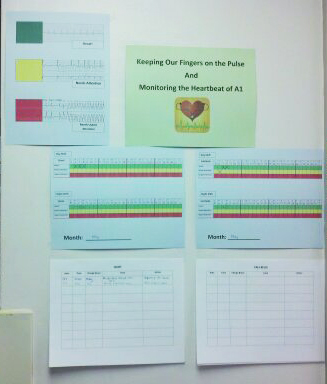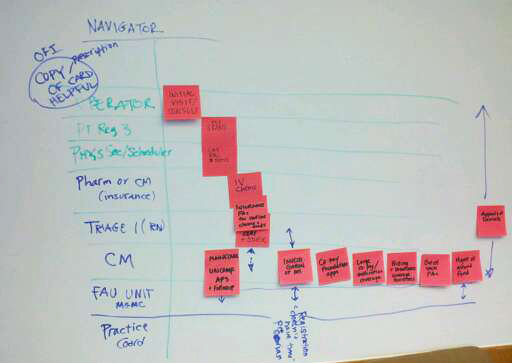I’m the lean engineer in MaineGeneral Medical Center in Augusta, Maine. For 17 years I’ve worked in public health research and healthcare, and for the last nine, I’ve worked as a lean specialist. I’m proud to say I’ve led 39 lean projects and been a part of 150 kaizen events, many of which have led to sustainable improvements.
Clearly, I am passionate about lean thinking and practice, but I also know it can be difficult. So I like to go back to the core concepts. Many people think of lean as a set of tools and try to use the tools where they don’t necessarily apply. I always want to say, “If I gave you the same tools your mechanic uses, would you be able to fix your car the way he does?” Of course not. So if lean isn’t a set of tools you can apply anywhere, what is it? How do we apply lean to healthcare?
 In my experience, lean is a management philosophy, a methodology for process improvement including specific techniques and tools, a set of principles, and most importantly, a total shift in mindset. It’s a way leaders can change the way they think about continuous improvement. It’s a way for practitioners not to give up when things don’t go as planned. And it’s something we all must learn, whether we are senior leaders or frontline workers in the trenches. Lean is a reminder that 80% or more of any workflow and performance issues are actually system and process related problems, not people problems. It’s a call to stop the blame game and start looking at processes and systems. It’s a way of helping people come to work and ask themselves, “How can I make things better”? If we are thinking lean, problems aren’t a bad thing; they are an opportunity for improvement.
In my experience, lean is a management philosophy, a methodology for process improvement including specific techniques and tools, a set of principles, and most importantly, a total shift in mindset. It’s a way leaders can change the way they think about continuous improvement. It’s a way for practitioners not to give up when things don’t go as planned. And it’s something we all must learn, whether we are senior leaders or frontline workers in the trenches. Lean is a reminder that 80% or more of any workflow and performance issues are actually system and process related problems, not people problems. It’s a call to stop the blame game and start looking at processes and systems. It’s a way of helping people come to work and ask themselves, “How can I make things better”? If we are thinking lean, problems aren’t a bad thing; they are an opportunity for improvement.
Lean is difficult because it’s different than what so most of us have been taught. How often do you hear the statement “think outside the box”? Lean tells us to move toward the box, not away from it, and to look at it. As lean thinkers, we break down the box into parts and steps using process mapping tools, identify value added and non-value added activities, calculate non-value added time, create flow, and implement a pull system, and then we seek perfection using PDCA.
So if you are new to lean and just getting started, here are a few things to keep in mind:
- Lean is a completely new way of thinking about continuous improvement, creativity, and innovation, NOT an add-on to your current way of thinking. If we consider lean as an add-on to other approaches (i.e. human relations, Taylor-ism) we end up with too many approaches. What we really want is for lean thinking to replace old, outdated models of management.
- It’s not possible to replace old thinking with new (lean) thinking right away. There’s always a transitional state between the old and the new. When we are at the tipping point between two, we need to keep doing what we are doing until we are sure that lean practices and principles are fully in place.
 For example, in the case of communication: in an ideal lean environment, communication between one part of the organization and and another is hard-wired into the processes of the larger system (i.e. kanbans, andons, process dashboards, scorecards, etc.). Lean says that communication problems are the result of a poorly designed system, not the cause. A good system institutionalizes communication processes into the workflow. The idea is that we should never be waiting on someone to give us information. Good processes should handle all information needs, and visual management tools can be used to support all processes. But when lean is a new way of thinking and doing business, as it so often is the case, we need to address communication issues from multiple angles. We must communicate communicate communicate until we know that the information that needs to be shared is shared.
For example, in the case of communication: in an ideal lean environment, communication between one part of the organization and and another is hard-wired into the processes of the larger system (i.e. kanbans, andons, process dashboards, scorecards, etc.). Lean says that communication problems are the result of a poorly designed system, not the cause. A good system institutionalizes communication processes into the workflow. The idea is that we should never be waiting on someone to give us information. Good processes should handle all information needs, and visual management tools can be used to support all processes. But when lean is a new way of thinking and doing business, as it so often is the case, we need to address communication issues from multiple angles. We must communicate communicate communicate until we know that the information that needs to be shared is shared.
3) Lean is about trying something new, so don’t be afraid to fail! The emphasis is on learning by doing. Most of us are good at brainstorming, but not so good at “try-storming”. We must have the guts to try new ways of doing our jobs. As long we do PDCA, we have nothing to fear. Lean thinking requires both humility and confidence, and it’s actually a framework to help us develop these qualities in ourselves and our team members.
What do you find most challenging about getting started with Lean?





